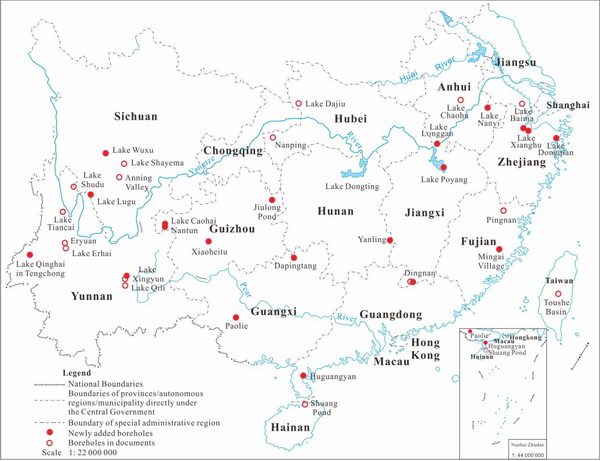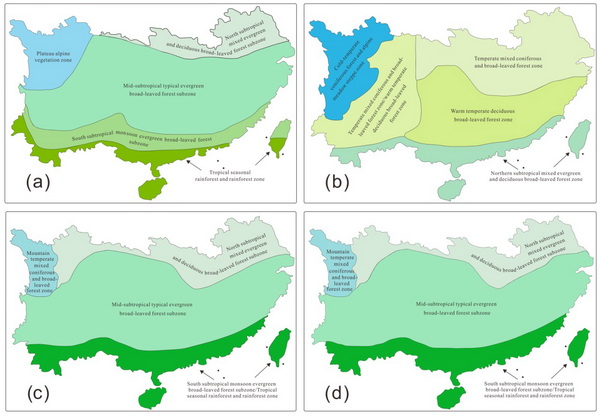The climate on the earth has gradually warmed up since the last glacial maximum some 20,000 years ago. Appropriate climate conditions have contributed to the formation and development of the Holocene farming culture. The way of production and lifestyle for the ancient people gradually changed from the early collecting, fishing and hunting to the later settled production with farming agriculture. This change in production and lifestyle was closely related to the environment variations at that time, and had a great impact on the development of human civilization. Vegetation in southern China has undergone significant changes since the last glacial maximum. Given the limitations of data, we still lack a comprehensive understanding of the concrete changing process and its relationship with human farming life.
In order to better understand the variations of vegetation with climate fluctuation since the last glacial maximum in southern China, as well as the impact of human activities on vegetation, a research team consisting of Prof. WANG Weiming, Dr. SHU Junwu and Dr. CHEN Wei from Nanjing Institute of Geology and Palaeontology of Chinese Academy of Sciences, and Dr. LI Chunhai from Nanjing Institute of Geography and Limnology of Chinese Academy of Sciences, has carried out pollen study for 20 drilling cores in some less researched areas. Finally, pollen data from 14 sites have been selected for the restoration of vegetation over the past 20,000 years. The research results have recently been published on the journal Chinese Science: Earth Sciences.
The research team gave for the first time the vegetation zoning maps around 18 ka BP, 9 ka BP and 6 ka BP respectively, and the distribution characteristics of plants in each zone/subzone are described. The main results are as follows:
1) The variation of vegetation in southern China since about 20,000 years generally coincides with the changing process of global climate after the last glacial maximum. Temperate vegetation around 18 ka BP can extends southward to the present south subtropical subzone, reflecting that the nature of vegetation still retained some climatic characteristics of the previous glacial period, although the climate had begun to warm up at that time.
2) During the Holocene megathermal, the characteristics of vegetation in the study area are rather distinct, which indicates similar features around both 9 ka BP and 6 ka BP. This reflects the general trend of global warming at that time on the one hand, and the overall control of southeast monsoon and southwest monsoon in southern China on the other hand. It is speculated that the long-term strong monsoon climate since 9 ka may be the main reason for the dominant vegetation distribution at that time, and its gradual convergence with the present.
3) High-resolution palynological study shows that although some climatic events since the last glacial maximum have been documented in some stratigraphic profiles, they have limited impact on the overall nature of local vegetation. In addition to the global climate change, the vegetation in the study area is also affected by the evolution and development of monsoon climate.
4) Human activities are not clearly reflected in 9 ka BP and 6 ka BP vegetation maps, which indicates that early farming activities have little influence on the original vegetation. The impact of human activities on vegetation is generally earlier in the middle and lower reaches of the Yangtze River than in the other areas of southern China, and the impact is more distinct.
5) The rise of sea level during the Holocene megathermal might also affect the distribution of vegetation at that time. Large-scale transgressions were recorded in Lake Dongqian, Lake Baima and Lake Xianghu in the early Holocene.
This work was supported by the Strategic Priority Research Program of Chinese Academy of Sciences and the National Natural Science Foundation of China.

Geographic location map of newly added boreholes and boreholes in documents. solid dots, Newly added boreholes; hollow dots, boreholes in documents

Vegetation zoning map in southern China. (a) Modern vegetation zoning map; (b) 18 ka BP vegetation zoning map; (c) 9 ka BP vegetation zoning map; (d) 6 ka BP vegetation zoning map
Contact:
Prof. Wang Weiming, Principal Investigator
Email: wmwang@nigpas.ac.cn
Nanjing Institute of Geology and Palaeontology, Chinese Academy of Sciences
Nanjing, Jiangsu 210008, China
Download:
